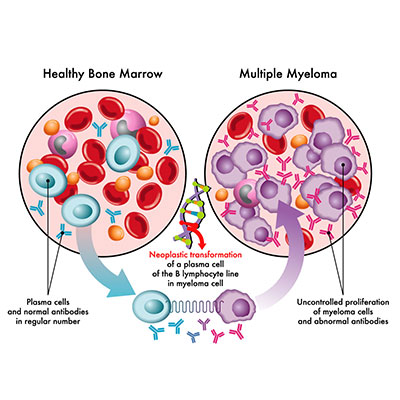
Multiple myeloma


Overview
Multiple myeloma is the development of a rare blood cancer that affects the plasma cells (also called B cells). Plasma cells are a type of white blood cell that help the body fight infections by producing antibodies called immunoglobulins.
Multiple myeloma occurs when abnormal cells multiply and produce antibodies knows as M proteins. As this happens, the disease can affect the bones, kidneys, and the ability to produce healthy blood cells.
Multiple myeloma could affect a person without any symptoms, The disease is slow progressive during the early stage, and the immediate treatment is not necessary, however, regular monitoring for the signs and symptoms is recommended to slow the progression of the disease.
Symptoms
Signs and symptoms of Multiple myeloma are as follows:
- Numbness or weakness of the arms and legs.
- Brain fog or confusion
- Bone pain
- Unexplained weight loss
- Nausea and vomiting
- Loss of appetite
- Frequent infection
- Unexplained bruising or bleeding
If you notice any signs and symptoms that are persistent then you could make an appointment with your doctor.
Causes
The cause of multiple myeloma is still unclear. It is known that the disease develop from just one abnormal plasma cell in the bone marrow that has rapid multiplication. The cancer cells do not mature and die as normal cells do. Once this multiplication of cancer cells occurs, the healthy cells become less and therefore the body is not able to fight the infection and becomes fatigued.
The myeloma cells produce abnormal antibodies, known as Monoclonal proteins or M proteins. These begin to build up in the body causing damage to the bones and the kidneys.
Monoclonal gammopathy of undetermined significance (MGUS), a generally benign condition, is usually the initial stage of multiple myeloma. Similar to multiple myeloma, MGUS is characterized by the presence of M proteins in your blood, which are made by abnormal plasma cells. Although there is no bodily harm, M protein levels are lower in MGUS.
Risk factors
Factors that may increase leukemia risk includes.
- Family History: it is highly possible to develop multiple myeloma if a direct member of the family is diagnosed with the disease.
- Age: those who are older are more prone to have multiple myeloma. Most patients diagnosed with the cancer are more than 65 years old.
- Gender: males are more likely to develop multiple myeloma than women.
- Obesity: person who are overweight or obese are high risk for the disease.
- Other plasma cell disease: person with monoclonal gammopathy of undetermined significance (MGUS) or solitary plasmacytoma has a higher risk to develop the disease.
Contact Information
service@vejthani.com






















